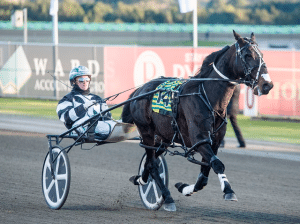
Before you start wagering on the standardbred horses in harness racing, you will need to educate yourself on the difference between pacers and trotters. These are the two types of horses which compete, but they do not compete against one another. Each of them has a distinctive running style which dictates how they race.
Understanding Harness Racing
The humble beginnings of harness racing can be traced to a time when buggies and horses were a popular form of transportation. It was only natural that some buggy owners, especially young males, began to challenge each other to the occasional race. This in turn evolved into a more formal style of competition and the creation of harness tracks.
Trotters and pacers do not compete but they do use similar equipment. The main piece of equipment is the sulky or buggy and a long set of driving reins. The sports gets its name because both the pacer and the trotter are said to be “in harness.” This means that they are wearing a bridle, girdle, and a headpole which runs along the side of the horse’s body. The headpole is designed to keep the horse’s head from turning during a racing event.
Trotters and Pacers are Standardbreds
The horses who compete in thoroughbred racing are thoroughbreds. All of these horses can trace their lineage to one of three original stallions. In harness racing the breed of horse that competes is called a standardbred. While these horses can be attributed an English descent, the standardbred horse is a product of the United States. About 90% of the standardbreds racing today can trace their ancestry to the famous sire Hambletonian.
Hambletonian competed in the 19th century and was a trotter. He was one of the fastest to ever compete. After his racing career was over, Hambletonian went on the become even more famous as a sire. Today there are even stakes races named in his honor, and many standardbred horses incorporate his name into their own.
Most standardbred racing horses are either bay or brown in color. It is rare but not unheard of for a standardbred to be black or chestnut in color. They can be as short as 14 hands but most often approach heights of 17 hands. Their big bodies are ideally suited for pulling a heavy load. The name standardbred was given to these horses in reference to the standard time for running a mile. The current standard is monitored and used by handicappers who are trying to pick winners.
Trotters
The trotter is the standardbred most casual observers will be familiar with. Those who have actually ridden a horse in real life will understand what a trot is. The essence of a trot is when the horse moves it’s diagonal legs in tandem with one another. The right front leg strikes the ground at the same moment the left rear leg strikes and vice versa. This method of traveling produces a distinctive two-beat gait.
You may notice that some trotters have a loop of what appears to be rope around their front legs as they compete. This piece of equipment, known as hopples, is designed to help the trotter maintain their stride at a high speed. In contrast, when a thoroughbred starts to move at high speed the horse exits a trot and adopts a different running style.
Pacers
Most of the standardbred horses competing today are pacers. The pacer, in contrast to the trotter, moves the legs on the same side of its body in tandem. The right front and right rear leg move together and vice versa. It is common to see hopples on both the front and rear legs of the animal to assist with maintaining this gait.
A curious thing is that pacers can often be retrained after their racing careers are over and function as trotting horses for recreational riding. The same cannot be said of trotters. There has been significant research done in Sweden which indicates that the ability to pace is genetic.
Did you know that you can watch and wager on harness racing right now at an online horse betting site? Check our Bovada racebook review, Twinspires review or even our Betamerica review. All great choice if you are in the US. 5Dimes review for folks anywhere! Signing up for an account takes just a few minutes and you can bet with your computer, smartphone, or tablet. You will also get a nice welcome bonus for signing up and also free past performances to help with your handicapping.



